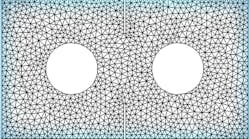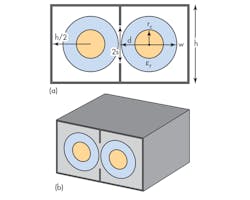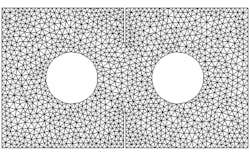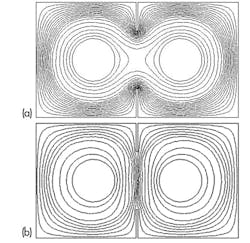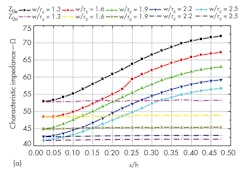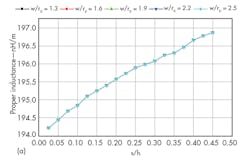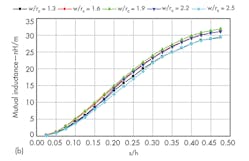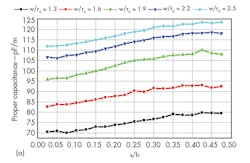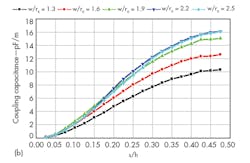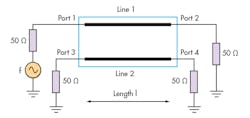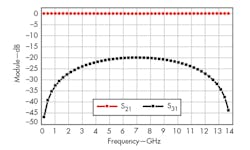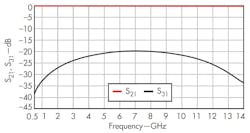This file type includes high resolution graphics and schematics when applicable.
Directional couplers are versatile performers in test setups and other RF/microwave systems in which signal power must be channeled and measured. In general, the choice of a directional coupler has involved a tradeoff between cost and performance. Hopefully, the use of modeling and simulation software can make the choice of directional coupler a bit less of a tradeoff. Traditional broadband couplers suffer from either high cost or low performance. For example, broadband waveguide couplers are bulky and costly. Stripline and microstrip directional couplers have attractive broadband characteristics, but they are affected by significant losses and low power-handling capabilities.
In contrast, coaxial structures would be ideal for their circuit losses and their high power-handling capabilities.1 Coupled coaxial lines have long histories of use in microwave filters, couplers, and other high-frequency components. The current project is focused on developing a new type of extremely low-cost, low-loss, broadband, high-performance coupler.
The practical solution adopted for these couplers is to partially fill rectangular coaxial cables and to insert thin metal diaphragms with a properly shaped aperture between the two inner conductors. The resulting air gap between the dielectric substrate and the ground plane will exhibit less circuit losses than the conventional coaxial cables2,3. Metallic diaphragms are used to partially separate the inner conductors and to easily control the coupling factor by means of adjusting the aperture half-width value (s/h ratio). This new structure can be realized without major difficulties and with simple, low-cost mechanical construction.
Figure 1 provides a graphical depiction of a rectangular coaxial coupler with metallic diaphragm, both in a cross-sectional view (a) and in a three-dimensional (3D) view (b) of the quasi-transverse-electromagnetic (TEM) rectangular coaxial coupler. Each coaxial line of this quasi-TEM coupler is assumed to be lossless, with an inner conductor radius of rc and an outer conductor of height h and width (h/2 + d).
The coaxial lines are partially filled with dielectric material of radius, w, and relative dielectric constant, εr = 2.03. A portion of each cable is cut out and coupled through thin metal diaphragms with negligible thickness to form the quasi-TEM coupled line. The cut depth is shown as d on the cross section, and the coupling level is adjusted by changing the aperture half-width (s/h ratio).
Various numerical techniques can be used to determine the accurate electromagnetic (EM) parameters of the quasi-TEM coupled lines. For example, analysis of high-frequency structures by means of finite-element method (FEM) may reveal a great deal about the expected EM behavior of those structures.4,5 The FEM is especially convenient for the computation of electric and magnetic fields in inhomogeneous media. Also, it has high computation accuracy and fast computation speed.
This numerical method was essentially applied for the characterization of the electromagnetic parameters: the even- and odd- mode characteristic impedances (Z0e, Z0o); the even- and odd- mode effective dielectric constants (εeffe, εeffo); the coupling coefficient, k; and the inductance and capacitance matrices, ([L] and [C], respectively) of the quasi-TEM rectangular coaxial coupler with metallic diaphragms,4,5 where:
In Eq. 1:
L0 = the proper inductance of the isolated lines;
C0 = the proper capacitance of the isolated lines;
M = the mutual inductance of the quasi-TEM coupled lines; and
γ = the coupling capacitance of the quasi-TEM coupled lines.
This file type includes high resolution graphics and schematics when applicable.
A Closer Look
This file type includes high resolution graphics and schematics when applicable.
To find the EM parameters of a quasi-TEM rectangular coaxial coupler with metallic diaphragms, analysis was performed on a structure portrayed in Fig. 1 with d/rc = 2.04. An FEM-based numerical tool was applied to show the effects of the metallic diaphragms (s/h ratio) and the dielectric radius (w/rc ratio) on the quasi-TEM coupler’s EM parameters.
Figure 2 shows the FEM meshes of the partially filled, rectangular coaxial coupler with metallic diaphragms using triangular elements. The potential distributions are presented in Fig. 3 for the even- and odd-modes with (s/h) of 0.25 and (w/rc) of 1.94. For different s/h and w/rc ratios, varying respectively between 0.025 and 0.475 and 1.3 and 2.5, the results obtained by FEM analysis can be seen in Figs. 4 through 7.
The EM parameters obtained through the FEM analysis were used to design and build a 20-dB directional quasi-TEM rectangular coaxial coupler with metallic diaphragms. All four ports of the coupler were matched to 50 Ω, as shown in Fig. 8. The fixed parameters of the 20-dB directional coupler include a characteristic impedance of (Z0e Z0o)0.5 = 49.62 Ω and an operating frequency of 7 GHz.
The features of the coupler obtained from the analytical results include an inner conductor radius of 1 mm; a coupler height of 5.4 mm; a d/rc ratio of 2.04; a w/rc ratio of 1.94 and an s/h ratio of 0.25; a coupler length (l) of 8.4 mm, even-mode characteristic impedance (Z0e) of 54.8 Ω; odd-mode characteristic impedance (Z0o) of 44.93 Ω; even-mode effective dielectric constant (εeffe) of 1.577; odd-mode effective dielectric constant (εeffo) of 1.7; and [L] and [C] found as follows:
Using MATPAR software, the S-parameters of the designed quasi-TEM rectangular coaxial coupler with metallic diaphragms (with respect to 50 Ω) were plotted in Fig. 9.6 MATPAR is a software package that allows a user of MATLAB software from MathWorks to take advantage of parallel computers for large problems, helping to speed the processing of complex problems.
For this type of quasi-TEM rectangular coaxial coupler with metallic diaphragms, there are no numerical or experimental results readily available in the scientific literature. To check the numerical FEM calculations, some parallel processing was required on another solver, using the same geometrical and physical parameters for the quasi-TEM directional coupler in both simulation methods.
For a “reinforcement” to the FEM calculations, simulations in 3D were performed using CST MICROWAVE STUDIO software (Fig. 1) from Computer Simulation Technology.7 By employing the CST MICROWAVE STUDIO’s Transient Solver, the resulting scattering parameters (with respect to 50 Ω) for a quasi-TEM rectangular coaxial coupler measuring 9.48 × 5.40 × 8.40 mm3 were plotted in Fig. 10 for frequencies from 0.25 to 14.00 GHz.
This file type includes high resolution graphics and schematics when applicable.
Summing Up
This file type includes high resolution graphics and schematics when applicable.
The results of Figs. 9 and 10 obtained respectively under MATPAR and CST environments show a good agreement of the frequency responses of S-parameters. They indicate the desired 20 dB coupling occurring from 5 to 9 GHz, which permit the designed quasi-TEM rectangular coaxial coupler with metallic diaphragms to have good coupling over a large frequency range.
In summary, this article has highlighted a new type of low-cost, low-loss, high-performance broadband quasi-TEM rectangular coaxial coupler with metallic diaphragms. Its EM parameters were evaluated and design curves were developed. The curves were used as the basis for designing a 50-Ω, 20-dB, quasi-TEM rectangular coaxial coupler with metal diaphragms measuring just 9.48 × 5.40 × 8.40 mm3 and operating at 7 GHz.
Computer simulations performed under MATPAR and CST design environments were reinforced by results obtained by measurements with commercial test equipment. The close agreement of the simulated and measured results represent progress in the design and modeling of quasi-TEM rectangular coaxial couplers with metallic diaphragms for microwave applications.
Yamina Bekri, Doctor
Dr. Nadia Benabdallah, Doctor
Dr. Djamal Lachachi, Engineer
Nasreddine Benahmed, Professor
University of Tlemcen, P.O. Box 119, (13000) Tlemcen, Algeria
References
1. H. An, R.G. Bosisio, and K. Wu, “Ultra-Wideband Directional Couplers with Coaxial Cable,” Canadian Conference on Electrical and Computer Engineering, Vol. 2, 1995, pp. 1160-1163.
2. G.L. Ragan, “Microwave Transmission Circuits,” MTT Radiation Laboratory Series, Vol. 9, McGraw-Hill, New York, 1948.
3. Hatsuda, Takeshi, “Computation of Impedance of Partially Filled and Slotted Coaxial Line,” IEEE Transactions on Microwave Theory & Techniques, Vol. MTT-15, No. 11, November 1967, pp. 643-644.
4. N. Benahmed and M. Feham, “Finite Element Analysis of RF Couplers with Sliced Coaxial Cable,” Microwave Journal, Vol. 43, No. 11, November 2000, pp. 106-120.
5. A. Lallam, N. Benabdallah, N. Benahmed, and Y. Bekri, ‘‘Analyze EM Parameters of Slotted Tube Couplers,” Microwaves & RF, Vol. 47, No. 3, March 2008, pp. 76-86.
6. A.R. Djordjevic, M. Bazdar, G. Vitosevic, T. Sarkar, and R.F. Harrington, Scattering Parameters of Microwave Networks with Multiconductor Transmission Lines, Artech House, Norwood, MA, 1990.
7. CST - Computer Simulation Technology, 2010.
This file type includes high resolution graphics and schematics when applicable.
